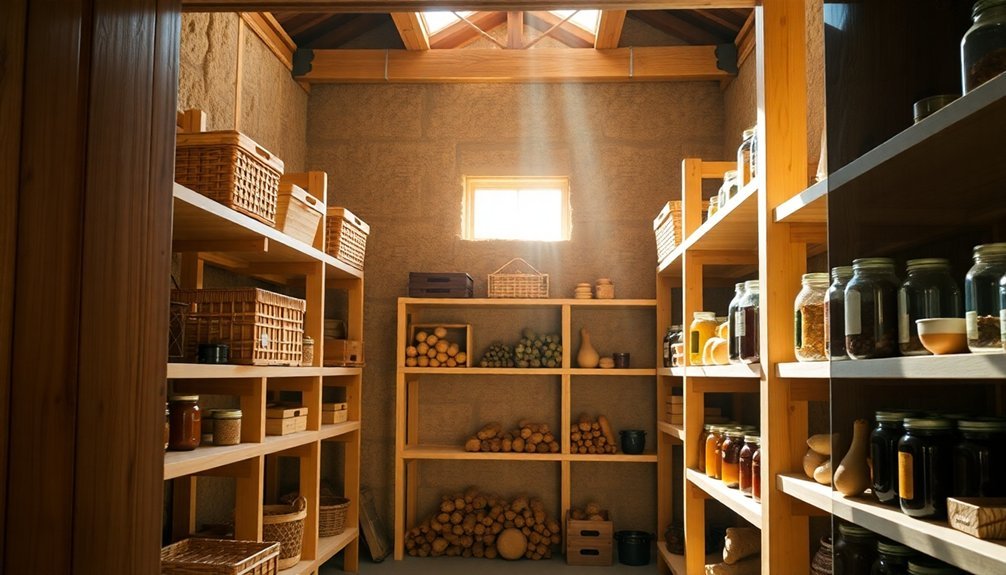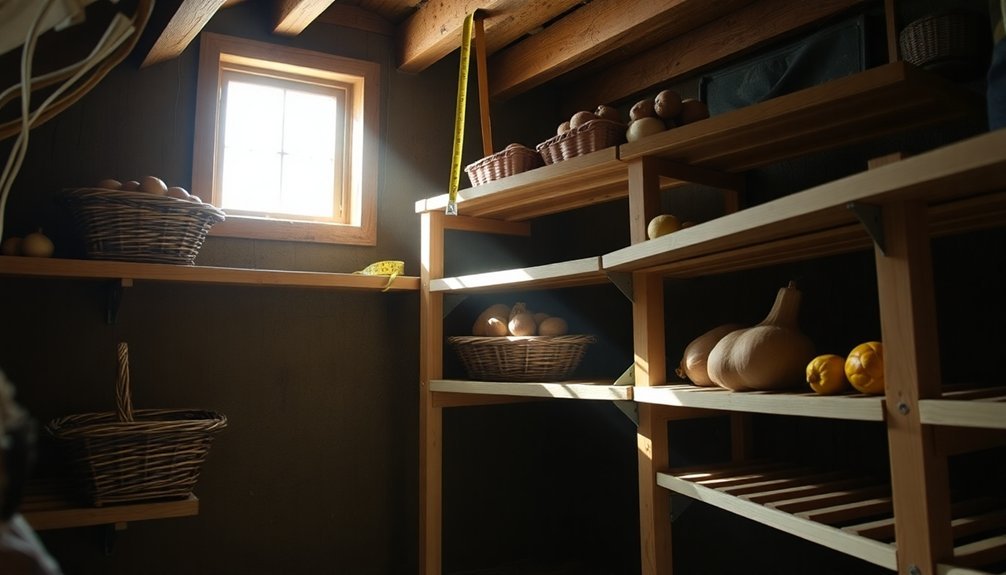Building adjustable root cellar shelving lets you maximize your storage space while protecting your harvest. You'll create customized zones for different produce types, maintaining ideal temperature and humidity levels for each. The flexibility allows you to adapt to seasonal changes and varying crop volumes throughout the year. You can efficiently separate ethylene-producing items, prevent premature spoilage, and guarantee proper air circulation. The adjustable design also makes maintenance and cleaning easier, while helping you build long-term food security. Discover how this versatile storage solution can transform your root cellar's effectiveness.
Maximizing Storage Space

Three key strategies can transform your root cellar into a highly efficient storage space.
First, you'll want to make the most of your vertical space by installing shelves at multiple heights. This approach lets you accommodate produce of varying sizes while maximizing your storage capacity from floor to ceiling. Maintaining a cool humidity level helps preserve your stored fruits and vegetables longer.
When you install adjustable shelves, you're creating a flexible system that adapts to your changing storage needs throughout the year.
Second, you'll optimize your storage by incorporating bins and containers that fit perfectly on your shelves. Choose stackable containers that allow proper air circulation to prevent moisture buildup, and don't forget to label everything clearly.
This system helps you organize different types of produce while maintaining ideal storage conditions.
Finally, don't overlook those often-wasted corners and nooks. You can install corner shelves or carousels to utilize these spaces effectively.
Consider adding narrow shelves in tight spaces or between walls, and use the area under your main shelving units for additional storage. For corner spaces, a turntable or lazy Susan can provide easy access to items that might otherwise be difficult to reach.
Customizing for Different Produce Types
Different types of produce require distinct storage conditions in your root cellar, so you'll need to customize your shelving setup accordingly.
Root vegetables like potatoes, carrots, and beets need shelving in the dampest, darkest areas with high humidity levels approaching 100%. You'll want to position these shelves low to the ground where moisture naturally collects. A well-planned system should maintain temperatures between 32 and 40 degrees for optimal preservation.
For fruits like apples and pears, create a separate shelving section with good ventilation to manage ethylene gas. You can use slatted shelves or well-ventilated bins to guarantee proper airflow.
When storing cole crops and leafy greens, set up shelving in areas with high humidity and cool temperatures, similar to root vegetables, but make sure you've got enough space to wrap or cover them properly.
Place shelves for squash, onions, and garlic in the driest areas of your cellar. These items need good air circulation, so install slatted shelves or wire racks that allow air movement.
You'll want these shelves to be easily accessible for regular checks and rotation. By customizing your shelving layout based on each produce type's specific needs, you'll greatly extend the storage life of your harvest.
Reducing Energy Costs

While building an efficient root cellar requires careful planning, you can greatly reduce your energy costs through strategic design choices. By incorporating proper insulation in your shelving system and surrounding walls, you'll maintain stable temperatures without relying on mechanical cooling or heating systems. Most root cellars maintain temperatures between 50-59°F for optimal food preservation.
Using materials like foam insulation or natural alternatives helps prevent heat transfer and keeps your storage space consistently cool.
You'll want to enhance your ventilation setup with adjustable vents or air ducts that you can control based on seasonal needs. This natural airflow management eliminates the need for powered ventilation systems while effectively controlling humidity levels.
When you're installing lighting, choose LED bulbs with motion sensors or timers to minimize electricity consumption while maintaining necessary visibility.
Consider integrating energy-efficient appliances if your root cellar requires additional climate control. Energy star-rated fans or cooling units will help maintain ideal storage conditions without excessive power usage.
You can even incorporate renewable energy sources like solar power to operate these systems. By combining these energy-saving features with your adjustable shelving design, you'll create a sustainable storage space that keeps your utility costs low while preserving your produce effectively.
Building Food Security
Beyond saving energy, adjustable root cellar shelving plays a key role in building long-term food security for your household. You'll be able to store various vegetables from multiple harvests while maintaining ideal conditions that extend their shelf life without relying on electricity.
The adjustable shelving system lets you create dedicated spaces for different types of produce, each with its own temperature and humidity requirements. You can easily modify the configuration to accommodate carrots, beets, parsnips, and potatoes in separate sections, preventing cross-contamination and ethylene gas buildup that could lead to premature spoilage.
Your shelving setup will maximize storage capacity through customizable arrangements and vertical space utilization. You'll find it easier to organize, rotate, and access your stored produce, making regular maintenance checks more efficient.
With proper temperature control (32-40°F) and humidity levels (85-95%), you'll preserve the flavor and texture of your vegetables throughout the winter months.
This systematic approach to food storage guarantees you'll have access to a diverse supply of preserved produce when you need it, greatly enhancing your household's food security and self-sufficiency during off-season periods.
Simple Maintenance Solutions

Simple maintenance tasks guarantee your root cellar shelving system operates at peak efficiency. You'll need to regularly inspect your shelves for signs of wear, pests, or mold while keeping the entire storage area clean and sanitized.
Using moisture-resistant materials like metal or plastic makes this task much easier and more effective. Proper ventilation is essential for your shelving system's longevity. You should check mesh-covered vents regularly and adjust them to maintain ideal humidity levels.
Watch for moisture absorption in your shelving materials and address any issues immediately to prevent damage to both the structure and your stored produce.
To maximize your shelving system's effectiveness, organize your produce strategically. Place heavier items on bottom shelves and lighter ones on top. You'll want to maintain proper air circulation by avoiding overcrowding and rotating stored items regularly.
Remove any spoiled produce promptly to prevent contamination of nearby items. Keep your root cellar dark and monitor temperature consistency. If you're storing onions and potatoes, use mesh bags and keep them in designated areas.
These simple maintenance practices will greatly extend your shelving system's lifespan while protecting your stored produce.
Adaptable Storage Design
Your root cellar's storage space can work harder with flexible shelving that adapts to your changing needs throughout the year.
You'll maximize efficiency by adjusting shelf heights and configurations to accommodate different produce sizes, from tall leeks in summer to compact root vegetables in winter.
Strategic seasonal planning lets you modify your storage layout based on harvest timing, ensuring you're ready for each crop as it comes in from the garden.
Flexible Space Management Solutions
While traditional root cellar storage can be limiting, implementing adjustable shelving systems transforms your space into a dynamic storage environment that adapts to changing needs.
You'll find that flexible space management solutions offer remarkable versatility in maximizing your root cellar's potential, allowing you to modify storage configurations as your requirements evolve.
To make the most of your adjustable shelving system, consider these key management strategies:
- Utilize vertical space by installing adjustable shelf heights, effectively doubling or tripling your storage capacity without expanding your cellar's footprint.
- Configure shelving units to accommodate different produce sizes and types, ensuring optimal space utilization while maintaining proper airflow.
- Implement modular components that you can easily reconfigure as seasonal storage needs change throughout the year.
- Create designated zones with clear labeling systems to maintain organization and streamline produce retrieval.
Seasonal Storage Planning
Effective seasonal storage planning requires a thoughtfully designed shelving system that adapts to the ever-changing needs of your root cellar.
You'll need to accommodate various vegetables with different storage requirements, from cool-loving onions and potatoes to warmer-preferring squash varieties.
Your storage needs will fluctuate dramatically throughout the year, with peak demands during fall harvest season. You'll want shelving that can expand to hold larger volumes during these busy periods and contract during lighter storage months. This flexibility guarantees you're maximizing your space efficiency year-round.
Managing ethylene gas production is essential for preventing premature spoilage. With adjustable shelving, you can create proper separation between ethylene-producing items and sensitive produce while maintaining adequate airflow throughout your cellar.
You'll need to regularly reorganize your storage setup to prevent gas buildup in specific areas.
Regular maintenance becomes much simpler with an adaptable system. You can easily access all areas for inspections, quickly remove any spoiled items, and efficiently rotate your produce.
When you're cleaning or reorganizing, you'll appreciate having shelves that you can quickly adjust or temporarily remove to accommodate your maintenance tasks.
Frequently Asked Questions
What Tools Are Needed to Build Adjustable Root Cellar Shelving?
You'll need power tools like a circular saw, drill, and jigsaw, plus hand tools including a tape measure, level, and clamps. Don't forget fasteners such as screws, nails, and L-brackets.
How Much Weight Can Adjustable Root Cellar Shelves Typically Support?
Your adjustable root cellar shelves can support over 2,000 pounds of stored food and jars when properly built with sturdy materials like oak lumber and metal supports, excluding the weight of the shelving structure itself.
What Is the Best Material for Building Root Cellar Shelving?
White oak is your best choice for root cellar shelving, as it's highly rot-resistant and can support over 2,000 pounds of storage. Cedar's another excellent option, offering natural pest resistance and moisture durability.
How Often Should Adjustable Shelving Hardware Be Checked for Rust?
You'll need to check your adjustable shelving hardware every 6-12 months for rust. Don't forget to inspect after any moisture exposure, during seasonal changes, and include it in your annual root cellar maintenance routine.
Can Adjustable Shelving Be Installed in a Pre-Existing Root Cellar?
Yes, you can install adjustable shelving in your pre-existing root cellar. You'll need to assess wall strength, guarantee proper ventilation, and measure carefully. Just make certain you're using moisture-resistant materials for the installation.
In Summary
Building adjustable root cellar shelving is a smart investment in your food storage future. You'll maximize every inch of space while keeping different produce at ideal heights and conditions. It's an energy-efficient solution that boosts your food security and adapts to changing storage needs. With easy maintenance and flexible design options, you're creating a sustainable storage system that'll serve your household for years to come.





Leave a Reply